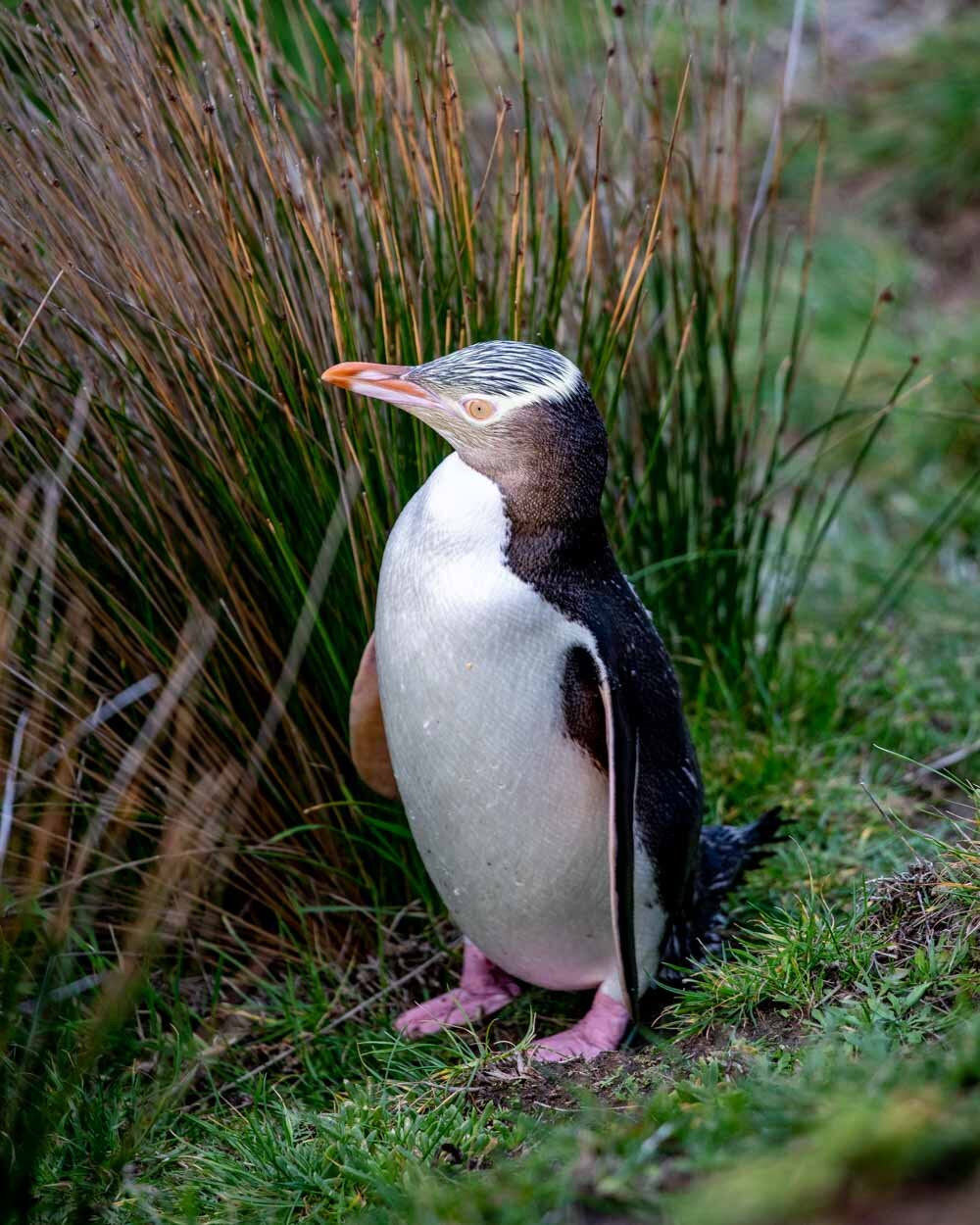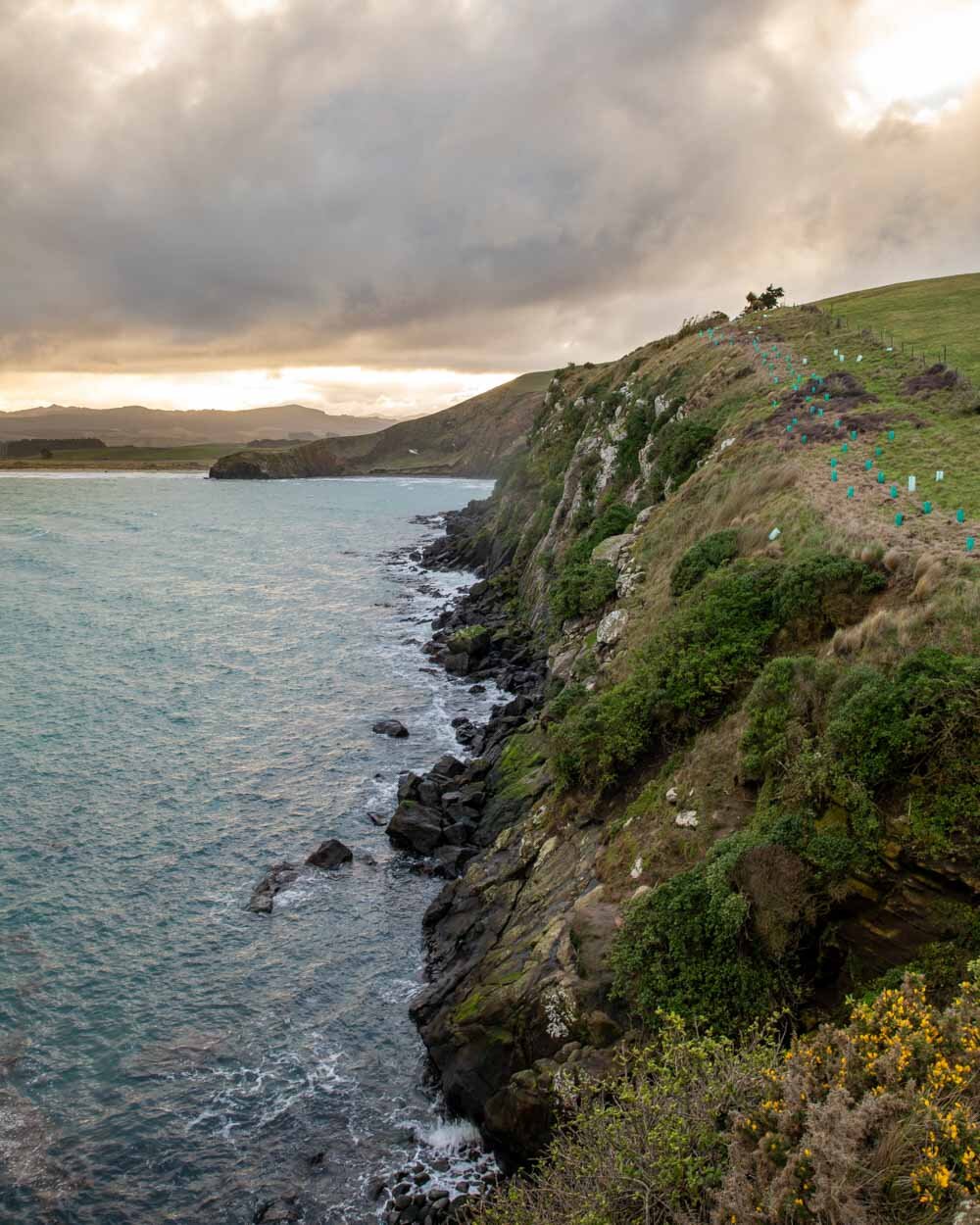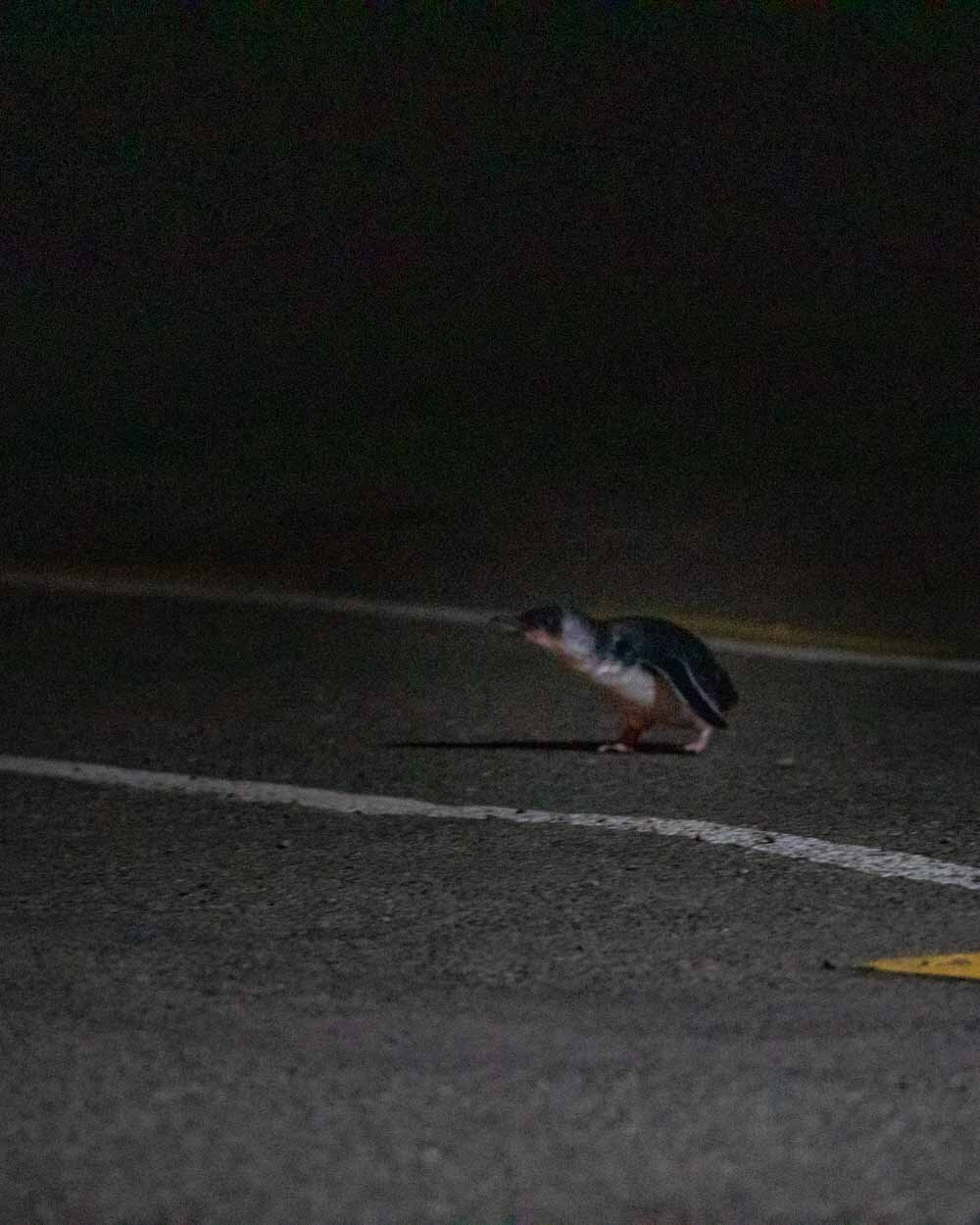We spent a week in Oamaru and most of it was dedicated to penguin spotting! Oamaru is best known for its incredible wild penguin viewing opportunities and for good reason. The blue penguin population is thriving and yellow-eyed penguins can also be seen both in Oamaru itself and very nearby. The spot just outside Oamaru was our best penguin experience so far and an absolute must do.
This guide is everything I would have found helpful to know about the various spots and experiences before visiting, including whether the paid penguin watching is worth it.
Here’s everything you need to know about tracking down Oamaru’s adorable penguins.
Where to find penguins in Oamaru
The yellow-eyed penguin (Hoiho)
The yellow-eyed penguin is one of the rarest in the world, and is so iconic that it graces the $5 bank note alongside Sir Edmund Hillary! These penguins are much larger than the little blue penguins in the area, and are characterised by the speckles of yellow in and around their eyes.
In terms of locations, I am going to start with a spot which is a 35 minute drive from Oamaru, purely because it is by far the best penguin experience we’ve had in New Zealand! The spots I’ll mention after are in Oamaru itself.
Katiki Point Lighthouse
The Katiki Point Lighthouse is an incredible place to spot yellow-eyed penguins in the wild. We went with no expectations and were absolutely blown away.
We were lucky enough to see 12 penguins here and their comical antics were just wonderful to watch. We saw them swim up from the ocean, waddle along the beach and then either potter around for a bit, or stop and take a rest or groom.
One even stood as if like a statue on top of a stoat box for over half an hour which seemed particularly apt!
They would creep past the slumbering seals on the beach, casting furtive glances in their direction and the whole experience was a joy to witness. It’s far and away our favourite penguin watching spot so far and a must do for wildlife lovers and photographers.
There is no hide here, so you’re free to move around as the penguins move and - though there is a fence to remind you to keep your distance - the penguins don’t know that, and will often climb up the banks and stand very close to you.
You are standing on the cliff bank and looking down to the beach, but you feel very close, not just to the cliffs but also to the beach itself. You can very easily see the penguins without binoculars or a zoom lens.
It’s a short walk from the car park to the beach where you’ll find the penguins, which takes around five minutes. The walk is on a well made dirt path and takes you past some farmland. It can get a little muddy after rain but nothing dramatic. It is predominantly downhill on the way so you’ll have a short climb on the way back.
The reserve does close at 5.30pm each day and viewing is best from around 3pm in December and January and then May to September and 4pm during the remaining months of the year. In October and November, and February and March you may also spot them before 7am.
Bushy Beach Scenic Reserve
Bushy Beach Scenic Reserve is in Oamaru itself and whilst I have seen penguins here twice, it is a very different experience to Katiki Point Lighthouse. There is a dedicated hide which is great for escaping the weather, but it’s very high up, far above the beach, as is the walkway to get there.
Unless the penguins come in very close the side of the beach where the hide is (it’s a huge beach) you will only see them as small blobs and I would highly recommend bringing binoculars.
The first time I saw a penguin here it had partially climbed up the cliff bank and I was able to get a pretty good view, the second time two penguins came in at the far side of the beach and I’ll be honest I literally couldn’t see them.
Joe could see them using the zoom lens (just), but with the naked eye you wouldn’t really know it was a penguin!
If you get lucky and they come up close to the side of the beach near the hide you will get a reasonable view, but even then it’s not a patch on Katiki Lighthouse. If you only have time to visit one spot it really is worth making that short drive.
The walk to the Bushy Beach hide is around five minutes on a well maintained path and it’s relatively level.
Tips for yellow-eyed penguin (Hoiho) watching
The great thing about Hoiho as opposed to the little blue penguins is that they come back from the sea in the daylight. This means the viewing and photography experience is much easier.
The general rule of thumb is they will start to emerge between 3pm and 4pm depending on the season, but it can be earlier and later too. As mentioned earlier in four months of the year there is also a decent chance of viewing them before 7am.
In Bushy Beach we got there two hours before sunset and they emerged almost two hours later, but at Katiki they were emerging from the water throughout the two hour period before sunset.
The penguins can spook quite easily and will sometimes not come out of the sea at all if they are unsure. For this reason you must keep off the beaches at both Katiki and Bushy Beach to allow them safe access to the shore. Keep noise to a minimum.
Blue penguins (Kororā)
Little penguins (also known as little blue penguins) are much smaller than yellow-eyed penguins, but are in much bigger numbers around Oamaru.
Unlike the yellow-eyed penguins, the blue penguins can only be viewed on land towards and after sunset.
Oamaru Blue Penguin Colony
The Oamaru Blue Penguin Colony is a wonderful place to view the little blue penguins but it does require an entry ticket (which goes towards conservation).
We were lucky enough to see 244 penguins come in to nest and that was in winter when numbers are generally much lower! Seeing that number of penguins is amazing and it’s almost like they put on a comedy show with their antics. It was easily one of our favourite things to do in Oamaru.
They try to sneak past the seals and if any are blocking the tunnels to their nests they will run back and fourth trying to decide if they’re brave enough to pass. One was so shocked to see the seal by the tunnel that it ran back towards the beach and then slipped down the rocks, which was funny as soon as we realised it hadn’t hurt itself!
Whilst the penguins are wild, the setting is less so. There are two seating areas almost like an open air theatre and flood lights so you can see them - they use warm light which the penguins cannot see. Whilst I do prefer to see wildlife in a more natural setting than this, it was an amazing experience to see so many penguins in one go.
There is a fair amount to know about the experience, including which seating is best, and we’ve put together a full (unsponsored) article on what to expect.
It’s worth noting that you are not allowed to photograph the penguins even if you don’t use a flash - the photos in our article are from Melbourne’s St Kilda colony.
Oamaru wharf
You can see the little blue penguins for free in a couple of different spots around Oamaru, but you will only see a handful. We did do this and whilst it was fun to spot them ourselves, it really doesn’t compare to the sheer numbers that you’ll see if you do the paid version. You also won’t have the lighting so you don’t get a good look at them in the same way.
If you want to give it a go then head down to the jetty on Waterfront Road and wait to hear their calls. You’ll definitely spot some from just after sunset onwards.
We saw ten, but all separately. Just remember not to get too close or photograph them using a flash, this is so important to their safety and well being. They really do scare easily.
It’s also worth noting that a large fence has been erected by the shore on Wansbeck Street, so you no longer see penguins come up to roost in the nooks and crannies of the buildings along Harbour Street (something locals said was always a treat to see).
Normally we are all about doing things independently but in the case of the little blue penguins in Oamaru there really is no comparison in experience. We were very glad we paid to see the bigger colony, and of course it’s also always good to support their conservation too.
The efforts of the Oamaru Blue Penguin Colony tour have led to a 10% increase in penguin numbers each year. The first time I visited was over 10 years ago and there were a fraction of the numbers you’ll see today.
This post may contain affiliate links, meaning at no additional cost to you, that we will earn a small commission if you click through and decide to make a purchase. This helps towards the costs of running our website. Thanks for your support!
























